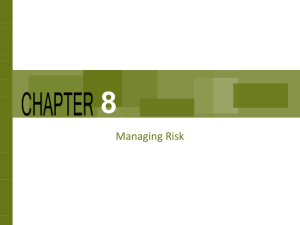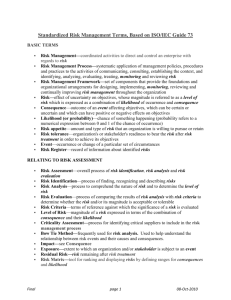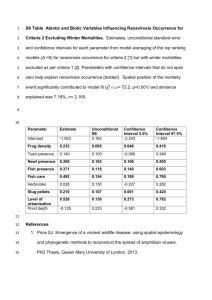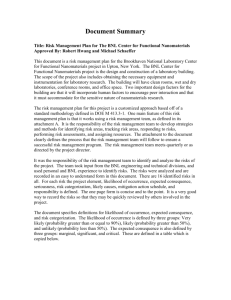Risk Management Plan
advertisement
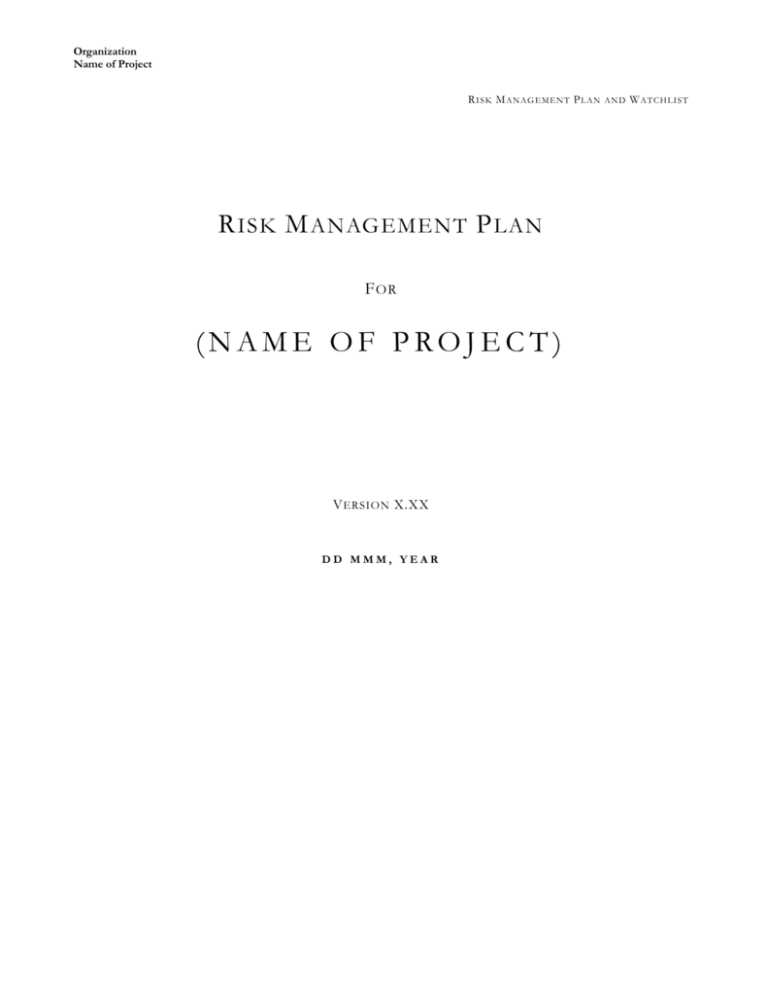
Organization Name of Project R I S K M AN AG E ME N T P LAN R ISK M ANAGEMENT P LAN F OR (NAME OF PROJECT) V ERSION X.XX DD MMM, YEAR AN D W AT C H LI S T Organization Name of Project R I S K M AN AG E ME N T P LAN D OC U ME N T I . R I S K M A NA G E M E N T O B J E C T I V E S The objectives of the risk management plan are: To focus attention on minimizing threats to achievement of the project objectives. To provide an approach for: - Identifying and assessing risks. - Determining cost-effective risk reduction actions. - Monitoring and reporting progress in reducing risk. The overall goal of this process is to progressively reduce the project’s exposure to events that threaten the accomplishment of its objectives by: Incorporating approaches into the project plans that minimize or avoid identified risks, Developing proactive, contingent risk response actions, and Rapidly implementing risk responses based on timely identification of risk occurrence. I I . R I S K M A NA G E M E N T R E S P ON S I B I L I T I E S The project manager will conduct risk management activities to address those risks that are pertinent to the project. The project manager will employ the assistance of members of the project team, project advisors and business lead as appropriate. Overview of Project Risk Management Activities Project Develop and maintain Project Risk List, Mitigation/Contingency Plan Assess and analyze risks Incorporate risk responses into the project plans (schedule, budget, tradeoff analysis) Monitor and identify risk occurrence Implement risk response contingency plans based on risk occurrence Document and report risks via a project risk watch list Overview of Risk Reporting To provide visibility of risks and progress in mitigating them, the risk watch list will be reviewed bi-weekly by the project team. If necessary, risk occurrences will be elevated to the business lead and project sponsors for their attention. P AGE 2 OF XX Organization Name of Project R I S K M AN AG E ME N T P LAN D OC U ME N T III. R I S K M A NA G E M E N T P ROC E S S The general risk management process to be followed by the project is as follows: RISK IDENTIFICATION/DESCRIPTION Review planning documents: - Deliverables and work processes - Milestones and schedule dates - Resource estimates/needs/sources - Performance requirements Talk with appropriate stakeholders and other experts to develop a comprehensive list of risks. Investigate the various sources and symptoms of risks to aid in subsequent determination of risk controllability and selection of appropriate risk response actions. RISK Analysis Quantify rough likelihood of occurrence and severity of impact, Impact Horizon and Controllability Assess Likelihood of Occurrence - Eliminate any risks which, on reflection, you believe will not occur. - Roughly classify the remaining risks as very likely or not likely to occur. Try to quantify "very likely" and "not likely" if possible. Assess Severity of Impact - Evaluate each risk in terms of its possible impact on the project’s baseline of effort/cost, time (schedule), and requirements (scope, performance, acceptance, and quality). - Eliminate any risks, which you believe have no, or only trivial impact on the baselines. - Roughly classify the remaining risks as big or little impact. Try to quantify "big impact" or "little impact" if possible. P AGE 3 OF XX Organization Name of Project R I S K M AN AG E ME N T P LAN D OC U ME N T Assign a value from “1” to “4” to each risk for each of the following: Likelihood Very Likely 3 1 Very Likely, Little Impact Not Likely Very Likely, Big Impact 4 2 Not Likely Little Impact Not Likely, Big Impact Little Impact Big Impact Impact Impact Horizon Assign either short term or long term. Try to quantify what you mean by "short term" or "long term". Whenever possible, assign the appropriate phase or phases. The ultimate goal is to assign an exact date when you expect the potential risk event to occur. Controllability Project risk can be controlled within the project team and/or company. External forces control project risk. Controllability Assessment Internal External RISK PRIORITY # Prioritize the risks. On the basis of your rough assessments, assign a prioritization number for the potential risk event. Prioritize Risks - Prioritize the identified risks on the basis of the rough risk evaluation (likelihood of occurrence and severity of impact), Impact Horizon, and Risk Controllability. RISK HANDLING STRATEGIES Your risk evaluation steps and the subsequent risk prioritization are crucial to developing risk response strategies. The choices are eliminate the cause, reduce the likelihood of occurrence, reduce the impact and accept the risk event. The project manager may choose one or a combination P AGE 4 OF XX Organization Name of Project R I S K M AN AG E ME N T P LAN D OC U ME N T RISK RESPONSE AREAS Essentially, all risk response strategies have an impact on the time, cost, quality, and external considerations such as the impact on other projects and the company as a whole. (Refer to the Strategic Risk Opportunity and Assessment Model to help evaluate external considerations). Mark this column a t, c, q or e. RISK RESPONSE STRATEGY IMPLEMEMENTATION Resources Needed To implement the selected strategy (ies) for each potential risk event, resources are needed. Cost estimates and schedule estimates for the implementation must be updated and the differences between the baseline and the additional resources must be accounted for. ASSIGNMENTS Make specific assignments to individuals. Put their names in this column. MONITOR RISK STATUS As work is performed, monitor and assess: Progress in reducing risk , Occurrence of risks that call for initiation of contingent risk responses, Effectiveness of implemented risk reduction actions and any needs to modify these actions. MAINTAIN THE RISK WATCH LISK Update the Risk Watch List to reflect the results of monitoring risk status. Also reflect the effect of any project re-planning changes and/or change controls. REPORT THE RISK WATCH LIST PROGRESS The Risk Watch List is should be discussed at project team meetings and specific risks should be elevated to the business lead and project sponsors as appropriate. P AGE 5 OF XX Organization Name of Project R I S K M AN AG E ME N T P LAN AN D W AT C H LI S T A P P E NDI X A XXX Project Risk Watch Risk ID # WBS # The following items are on the XXX project’s risk watch: Risk Identification/ Description Risk Analysis (1 to 4) Risk Impact Time Horizon (short term or long term/ phase/date) 1 2 3 4 5 6 7 Risk Control (internal or external) Risk Priority # Area of Impact Response Strategy(ies) Response Strategy(ies) (time, cost quality, other projects) C(reduce likelihood, reduce impact) Avoid Assume Transfer) Implementation Resources Needed Assigned Person to handle risk Date Completed MM/DD/YEAR Organization Name of Project R I S K M AN AG E ME N T P LAN D OC U ME N T Risk ID # WBS # Risk Identification/ Description Risk Evaluation (1 to 4) Risk Impact Time Horizon Risk Control (internal or external) Risk Priority # (short term or long term/ phase/date) Area of Impact Response Strategy Response Strategy (time, cost quality, other projects) (Eliminate, reduce likelihood, reduce impact, accept, transfer) Implementation Resources Needed 8 9 10 11 12 13 14 P AGE 7 OF XX Assigned Person to handle risk Date Completed MM/DD/YEAR
